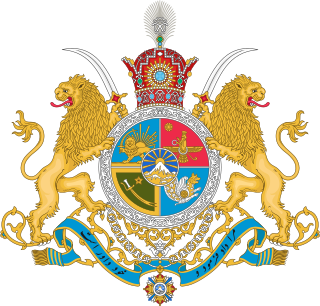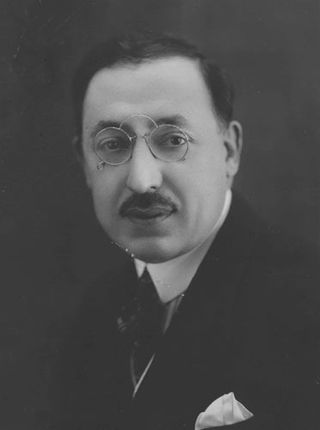
Mohammad Mosaddegh was an Iranian politician, author, and lawyer who served as the 30th Prime Minister of Iran from 1951 to 1953, elected by the 16th Majlis. He was a member of the Iranian parliament from 1923, and served through a contentious 1952 election into the 17th Iranian Majlis, until his government was overthrown in the 1953 Iranian coup d'état aided by the intelligence agencies of the United Kingdom (MI6) and the United States (CIA), led by Kermit Roosevelt Jr. His National Front was suppressed from the 1954 election.

Reza Shah Pahlavi was an Iranian military officer and the founder of the Pahlavi dynasty. As a politician, he previously served as minister of war and prime minister of Qajar Iran and subsequently reigned as Shah of Pahlavi Iran from 1925 until he was forced to abdicate after the Anglo-Soviet invasion of Iran in 1941. He was succeeded by his eldest son, Mohammad Reza Shah. A modernizer, Reza Shah clashed with the Shia clergy, but also introduced many social, economic, and political reforms during his reign, ultimately laying the foundation of the modern Iranian State. Therefore, he is regarded by many as the founder of modern Iran.

The Pahlavi dynasty is an Iranian royal dynasty that ruled for almost 54 years between 1925 and 1979. The dynasty was founded by Reza Shah Pahlavi, a non-aristocratic Mazanderani soldier in modern times, who took on the name of the Pahlavi language spoken in the pre-Islamic Sasanian Empire to strengthen his nationalist credentials.

The prime minister of Iran was a political post that had existed in Iran (Persia) during much of the 20th century. It began in 1906 during the Qajar dynasty and into the start of the Pahlavi dynasty in 1923 and into the 1979 Iranian Revolution before being abolished in 1989.

Liberalism in Iran or Iranian liberalism is a political ideology that traces its beginnings to the 20th century.

A referendum was held in Iran on 26 January 1963 by the decree of Mohammad Reza Shah, with an aim to show popular support for him, asking voters to approve or veto the reforms of the White Revolution.

Mohammad Reza Pahlavi, commonly referred to in the Western world as Mohammad Reza Shah, or just simply The Shah, was the last monarch of Iran. He began ruling the Imperial State of Iran after succeeding his father Reza Shah in 1941 and remained in power until he was overthrown by the 1979 Iranian Revolution, which abolished the country's monarchy and established the Islamic Republic of Iran. In 1967, he took up the title Shahanshah and held several others, including Aryamehr and Bozorg Arteshtaran.

Parliamentary elections were held in Iran on 13 March 1980, with a second round on 9 May. They were the first elections to the Majlis since the overthrow of the Shah, and were contested to a considerable degree on a party basis.

Parliamentary elections were held in Iran in 1947. The newly elected parliament was opened on 17 July. The election was a three-way power struggle between Ahmad Qavam, Mohammad Reza Shah and pro-Britain conservative politicians.

Parliamentary elections were held in Iran in 1952 to elect the 17th Iranian Majlis.

The Persian legislative election of 1923 was held in November 1923 after the appointment of Reza Pahlavi as Prime Minister by Ahmad Shah Qajar. It was the last election in the Qajar dynasty. Parliament opened on 11 February 1924.

Farah Pahlavi is the widow of the last Shah of Iran, Mohammad Reza Pahlavi, and was successively Queen and Empress of Iran from 1959 to 1979. She was born into a prosperous family whose fortunes were diminished after her father's early death. While studying architecture in Paris, she was introduced to Mohammad Reza at the Iranian embassy, and they were married in December 1959. The Shah's first two marriages had not produced a son—necessary for royal succession—resulting in great rejoicing at the birth of Crown Prince Reza in October of the following year. Farah was then free to pursue interests other than domestic duties, though she was not allowed a political role. She worked for many charities, and founded Iran's first American-style university, enabling more women to become students in the country. She also facilitated the buying-back of Iranian antiquities from museums abroad.
In 1949 a Constituent Assembly was held in Iran to modify the Persian Constitution of 1906. Shah Mohammad Reza Pahlavi convened the assembly in April; he sought a royal prerogative giving him the right to dismiss the parliament, providing that new elections were held to form a new parliament. He also specified a method for future amendments to the Constitution. The amendments were made in May 1949 by unanimous vote of the Constituent Assembly.

The Marble Palace is an historic building and former royal residence in Tehran, Iran. It is located in the city centre, but the location was a quiet quarter of Tehran when the palace was erected.

Pahlavi Iran, officially the Imperial State of Persia until 1935 and the Imperial State of Iran from 1935 to 1979, was the Iranian state under the rule of the Pahlavi dynasty. The Pahlavi dynasty was created in 1925 and lasted until 1979, when it was ousted as part of the Islamic Revolution, which ended Iran's continuous monarchy and established the current Islamic Republic of Iran.

Qajar Iran, also referred to as Qajar Persia, the Qajar Empire, Sublime State of Persia, officially the Sublime State of Iran and also known as the Guarded Domains of Iran, was an Iranian state ruled by the Qajar dynasty, which was of Turkic origin, specifically from the Qajar tribe, from 1789 to 1925. The Qajar family took full control of Iran in 1794, deposing Lotf 'Ali Khan, the last Shah of the Zand dynasty, and re-asserted Iranian sovereignty over large parts of the Caucasus. In 1796, Agha Mohammad Khan Qajar seized Mashhad with ease, putting an end to the Afsharid dynasty. He was formally crowned as Shah after his punitive campaign against Iran's Georgian subjects.
The elections for the sixth Majlis ended on 27 June 1926.

In the elections for the seventh Majlis, systematically rigged by the military and Interior ministry, handpicked representatives of Reza Shah were chosen to the parliament to ensure the exclusion of recalcitrants and "unsuitable candidates who insisted on running found themselves either in jail or banished from their localities".
Parliamentary elections were held in Iran in 1939, throughout the month of July and most of August. They were the last elections held during the reign of Reza Shah and were not considered free.
The 10th Islamic Consultative Assembly was the 34th Parliament of Iran that commenced on 28 May 2016 following the legislative elections on 26 February and 29 April 2016 and ended on 26 May 2020.













